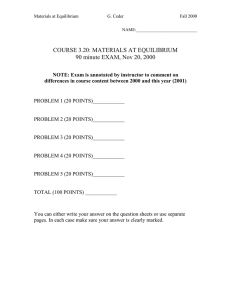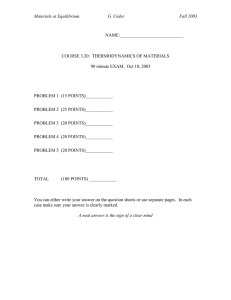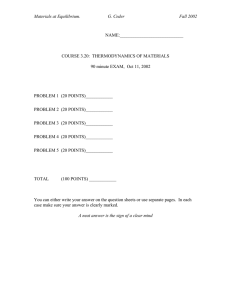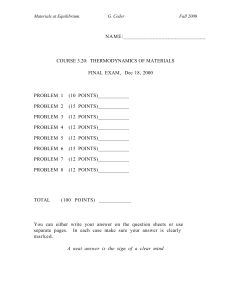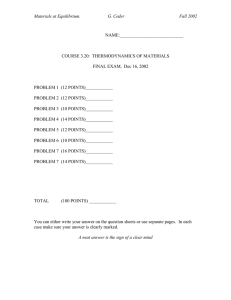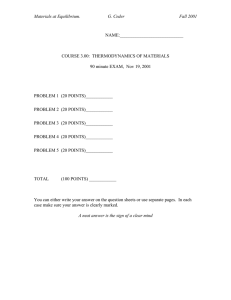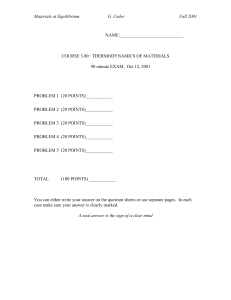Materials at Equilibrium. G. Ceder Fall 2001 NAME:____________________________
advertisement
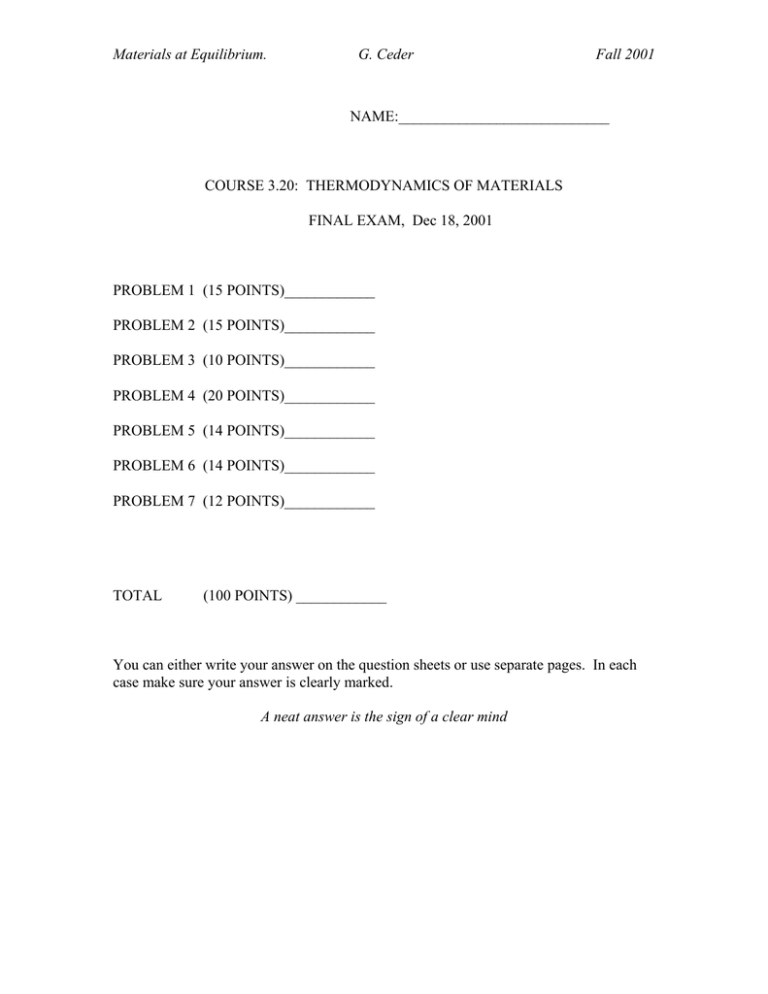
Materials at Equilibrium. G. Ceder Fall 2001 NAME:____________________________ COURSE 3.20: THERMODYNAMICS OF MATERIALS FINAL EXAM, Dec 18, 2001 PROBLEM 1 (15 POINTS)____________ PROBLEM 2 (15 POINTS)____________ PROBLEM 3 (10 POINTS)____________ PROBLEM 4 (20 POINTS)____________ PROBLEM 5 (14 POINTS)____________ PROBLEM 6 (14 POINTS)____________ PROBLEM 7 (12 POINTS)____________ TOTAL (100 POINTS) ____________ You can either write your answer on the question sheets or use separate pages. In each case make sure your answer is clearly marked. A neat answer is the sign of a clear mind Materials at Equilibrium. G. Ceder Fall 2001 Question 1: A bucket, containing 1 kg of water at 250C is sitting in an environment at the same temperature. The bucket sits on a shelf 2 meters above the floor. Someone kicks the shelf so that the bucket of water spills on the floor. Slowly the water evaporates until the puddle on the floor is gone. a) identify clearly the sources of entropy production (irreversibility) in the total process (initial state: bucket on the shelf; final state: water evaporated). You can neglect the person that kicked the shelf. b) calculate the entropy change in the universe for the total process. DATA: The vapor pressure of water at 250C is 0.03 atm. Air circulates well above the water puddle and is continually refreshed. The air temperature is 250C and the relative humidity in the air is 33%. The mixture of air and water vapor can be treated as an ideal gas mixture. Density of water; 1g/cm3 Molar Mass water: 18g/mol enthalpy of evaporation at 250C for water: 43.97 KJ/mol heat capacity liquid water at 250C 75 J/mol-K heat capacity vapor water at 250C 33 J/mol-K Materials at Equilibrium. G. Ceder Fall 2001 Question 2: Based on his empirical observations of alloy phase diagrams, Hume Rothery formulated several rules to predict mixing behavior. The second Hume Rothery rule states that metallic elements only form solid solutions when their atomic radii differ by less than 15%. a) Rationalize and discuss this rule based on what you know about the factors that determine alloy formation. b) The molar volume of Ti metal is 10.6 cm3/mole. The molar volume for Ag metal is 10.3 cm3/mole. Will the system be compound forming or phase separating ? Rationalize your guess. Note: Attached is a periodic table. c) The melting points for Ti and Ag are respectively 1943K and 1234K. Elemental Ti undergoes an allotropic phase transition at 1155K from hcp (low T) to bcc (high T). A graduate student in your lab determined part of the phase diagram of the Ti-Ag system (shown on the next page). Now that he is graduated you are asked to complete the diagram so your advisor can publish. Sketch a plausible completion of the phase diagram, consistent with what you decided for the behavior in part b). Pay particular attention to slopes, two-phase regions, extrapolations of lines etc. Materials at Equilibrium. G. Ceder Fall 2001 T Ti Ag Materials at Equilibrium. G. Ceder Fall 2001 Question 3: The work performed in creating surfaces can be added to the work flows in the First Law of Thermodynamics. If σ is defined as the surface energy per unit area, the work performed when creating new surface is σdA, where A is the surface area of the system. Separatium (Sp) has a surface energy (solid-gas) which over the temperature range of interest increases with temperature as B + C ln(T) with C and B positive constants. A single crystal of Sp is reversibly pulled apart as show in the figure below. The crystal is insulated so that there is no heat flow to the environment. a) Calculate the change in entropy of the system (per unit new surface area) as the crystal is isothermally and reversibly pulled apart. Answer can be in terms of constants B,C, and Temperature. b) What happens to the temperature of the system if the crystal is pulled apart adiabatically (but reversibly). Assume that there is no plastic deformation in the system while it is being pulled apart. Before After Materials at Equilibrium. G. Ceder Fall 2001 Question 4: Short questions. b) In a particular solid solution of A and B atoms with composition 50% A and 50% B, the probability PAA that a particular bond is A-A (as opposed to A-B or B-B), is 0.25. This state has a given configurational entropy of mixing S0 . In order to make the entropy increase, should I increase or decrease PAA ? c) A storage battery delivers a current into an external circuit that drives an ideal motor reversibly pulls up a weight. The battery remains at a constant temperature by absorbing heat from the surrounding atmosphere. Heat then appears to be completely converted into work. Is this a violation of the Second Law? Explain briefly. d) A compound forming binary alloy with atoms A and B is modeled with a lattice model. Applying Monte Carlo simulation to this lattice model, the heat capacity shown below is obtained. The heat capacity goes to zero at high temperature and does not approach the limit of 3R as expected from the law of Dulong and Petit. Explain this discrepancy. Materials at Equilibrium. G. Ceder Fall 2001 Materials at Equilibrium. G. Ceder Fall 2001 Question 5: A cylinder of material is clamped between immovable walls. Calculate the heat capacity of this material in terms of the heat capacity under constant pressure and constants such as the linear thermal expansion (αL), the Young’s modulus (E) etc. You may find the following formula useful: ∂x ∂x ∂x ∂y = + ∂f z ∂f y ∂y f ∂f z Materials at Equilibrium. G. Ceder Fall 2001 Question 6: Consider a linear chain of atoms whereby nearest neighbour atoms are connected by covalent bonds. Assume there are M such bonds. A force F is applied to the two end points of the chain. The covalent bonds connecting nearest neighbour atoms have some peculiar properties. The bonds are infinitely stiff meaning that their length does not change elastically under an external force. But each individual bond can be in an electronic ground state or an excited state (e.g. an electron in the bond can be in a bonding level (ground state) or an antibonding level (excited state)). When the bond is in the ground state the bond energy is ε0 and the length is l0 while in the excited level, the bond has energy ε1 and length l1. Also different bonds do not interact with each other. (a) Define N as the number of excited bonds. What is the total length L and total energy E of the linear chain in terms of N ? (b) At constant number of atoms in the chain (i.e. number of bonds M is constant), constant temperature T and constant external force F, obtain an explicit expression for the appropriate partition function. (c) How does the average length of the chain depend on the external force F. Materials at Equilibrium. G. Ceder Fall 2001 Question 7: A gas of A and B molecules is contained in a cylinder with a movable semi-permeable piston. The cylinder wall is diathermic so that the gas is at all times in equilibrium with the environment. The piston allows B molecules to transfer, but not A. Outside the partial pressures of A and B are respectively 0.6 and 0.2 atm. Initially the pressure inside the cylinder is 1atm. a) The piston is slowly displaced so that the volume is reduced to one half of the initial volume. What is the pressure inside the cylinder ? b) After the system is equilibrated from the change in a), the piston is locked (so that it can not displace anymore) and inject molecules of type C until their partial pressure equals 0.15. What is the pressure now ? c) I introduce a spark into the cylinder which causes C and B to react violently according to the reaction C + B -> BC. No new molecules of C are introduced. What is the pressure in the cylinder after the system is equilibrated ?
